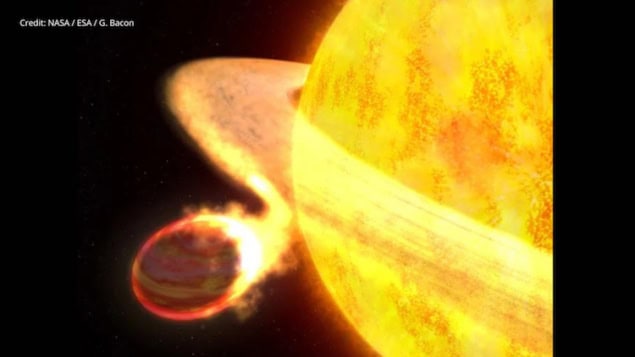
The fate of so-called “hot Jupiter” exoplanets is as fiery as it is inevitable. Over billions of years, these exoplanets – which have about the same mass as the familiar giant planet Jupiter, but much smaller orbits – will gradually spiral in towards their host stars until they collide with them.
For some hot Jupiters, though, this moment of reckoning isn’t happening as quickly as theory predicts – and now astrophysicists think they know why. According to a team led by Craig Duguid of Durham University, UK, the stars’ magnetic fields may be partially dissipating the gravitational tides responsible for the “doom spirals” of orbiting hot Jupiters. This explanation, which the team obtained by analyzing models of stars with convective cores, is consistent with observations of the exoplanet WASP-12b, which is destined to crash into its host star in just a few million years.
Of the more than 5000 exoplanets discovered to date, hot Jupiters are by far the most common type. This is partly due to limitations in observational techniques: because hot Jupiters are so massive, and orbit so close to their host stars, it is relatively easy to spot their effects with powerful telescopes. But their closeness is also their downfall, as it subjects both the hot Jupiters and their hosts to powerful gravitational tides. These tides transfer orbital energy from the exoplanet to the star, causing the planet’s orbit to decay until the planet is “swallowed up” by its host.
A wave-breaking hypothesis
WASP-12b, discovered in 2008 by the SuperWASP planetary transit survey, is a prime example of a doomed hot Jupiter. Thanks to its decaying orbit, it is due to collide with its host star, WASP-12, in a few million years, which is quite soon in astronomical terms.
The problem is that current theories of gravitational tides cannot fully explain WASP-12b’s orbital decay. One hypothesis that might resolve the discrepancy involves internal gravity waves (IGWs) that propagate towards the centre of the host star. Strong gravitational tides are known to excite IGWs, and recent work has shown that if IGWs reach the centre of the star, they can break in the same way as water waves break on a beach. Wave breaking is an extremely efficient source of tidal dissipation, as all the energy in the IGWs is lost to turbulence and heating. Indeed, it could provide enough dissipation to explain WASP-12b’s orbital decay – except for one thing.
“Wave breaking cannot occur if the star has a convective core – and WASP-12 does,” Duguid says, adding that it belongs to the family of F-type stars, which are 1.2 to 1.6 times heavier than our Sun and have convective cores.
This discovery left the tidal and observational community stunned, he says. “No other tidal theory could predict anything close to the amount of dissipation required for the rate of orbital decay observed – for example, my own study would suggest billions of years rather than a few million – but if the tidal theory was right, then the observations were wrong.”
A magnetic explanation
As an alternative, Duguid and colleagues focused on WASP-12’s magnetic field. Previous studies of how IGWs might convert into magnetic waves were carried out in a non-tidal context, but Duguid thinks such a conversion could happen for tidally excited IGWs, too – with important consequences. “Instead of the IGWs needing to reach the centre where they could break, they need only encounter a strong enough magnetic field that will cause them to be converted into outwardly propagating magnetic waves,” he explains. “These are then dissipated into heat.”
The mechanism is as efficient as wave breaking, he adds, since all the IGW energy is again lost to heat and turbulence. And importantly, it should still operate in stars that have convective cores – and probably won’t in stars that don’t. “The reason is that a convective core is likely to have a convectively driven dynamo able to generate a strong magnetic field,” he tells Physics World. “For WASP-12b, this mechanism can exist and hence explain the orbital decay rate while still agreeing with the observations.”
New mechanism for tidal dissipation
The Durham researchers, who detail their work in The Astrophysical Journal Letters, obtained their result by using the MESA code to assess whether IGWs could convert into magnetic waves for other F-type stars using estimates of the magnetic fields produced by a convective dynamo in the stellar cores.

Inferno-like exoplanet has ionized calcium in its atmosphere
“As well as being consistent with the observed inspiral of WASP-12b, we found that this previously unexplored source of efficient tidal dissipation can also operate in such stars over a significant fraction of their lifetimes,” Duguid says.
More generally, it could play an important role in how the orbits of hot Jupiters – and indeed other planets with ultra-short orbital periods – evolve over time, he adds.
“One important implication is that this new mechanism can guide observers to promising targets to detect tidally-driven orbital decay. Currently, only the orbit of WASP-12b has been confirmed to be decaying, but we expect many other planets orbiting F-type stars should be, too.”
Given the novelty of this mechanism for tidal dissipation, Duguid says there is much work to be done to understand the details of the fluid dynamics behind it and find out where the dissipated tidal energy goes within the star’s interior. “It is also quite exciting that the mechanism might be observationally tested within our lifetime,” he adds.



